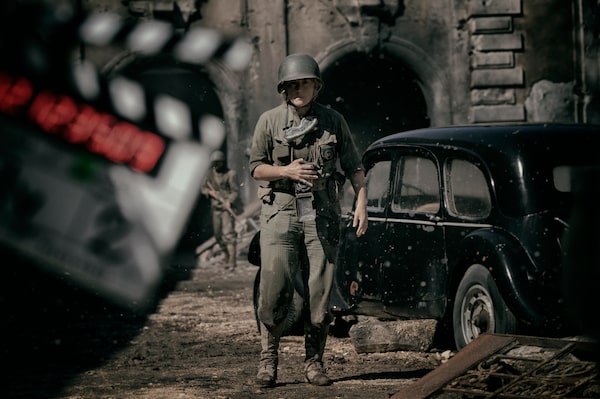
Kate Winslet as Second World War photographer Lee Miller in Lee, which will premier at the Toronto International Film Festival.Kimberley French/TIFF
A British Vogue editor, Audrey Withers (Andrea Riseborough) examines a stack of photographs shot by Elizabeth “Lee” Miller (Kate Winslet). The Second World War is raging, Miller is encamped with American soldiers, but these are not typical battle photos. They’re intimate, emotional, textured: bandaged bodies in a medical tent, nurses’ underthings drying in a barracks window. “Only a woman could have taken these,” Withers says.
And only women could have helmed the new drama Lee, which will have its world premiere Saturday night at the Toronto International Film Festival: the screenwriter Liz Hannah (The Post); the producer Kate Solomon (United 93); the director Ellen Kuras, making her feature debut after an award-winning career as a documentary maker, cinematographer (Eternal Sunshine of the Spotless Mind) and television director (Inventing Anna); and Winslet, who worked for nearly a decade to put the script, cast and crew together.
“It’s a story about a point of view,” Kuras said Wednesday in a video interview. “About what it feels like to look through Lee’s lens. To look where other people aren’t looking.”
“Lee had such incredible strength and determination,” Solomon said in a separate interview. “As a woman, she was told all the time, ‘You can’t.’ And she didn’t care – she did it. And Ellen, Kate and I, as women, in order to get where we are, also had to have determination and drive. All that stuff we carry with us, we pushed onto the screen. Lee is our icon for what she accomplished, and we’ve rushed up behind her to show it to everyone else.”
The real Miller (1907-1977) led a remarkable life, first as a model for photographers including Edward Steichen and Man Ray, then as a photographer herself, the centre of a circle of artists that included Picasso and Jean Cocteau. “She took control of her image, she wanted to be the author of what and how she saw,” Kuras says. Owning what you’re seeing and how you want to tell your story is common theme at TIFF this year, as a years-long push to diversify filmmakers begins to bear fruit. But the genius of Lee is its narrow focus, on Miller’s years as a photojournalist during the war, as she captures indelible images of the London Blitz, the siege of St. Malo (including some of the first shots of napalm being dropped), the liberation of Paris and the horrors of the Dachau and Buchenwald death camps.
Miller’s son Antony Penrose, who manages her estate, has a pile of scripts that others tried to make about her, “but they failed to get her,” he said in a joint interview with Solomon. “They didn’t understand that Lee first and foremost is an artist, and more importantly a surrealist. She stands for peace, freedom, truth, justice. She uses her art to make people angry about injustice. She was not just a lovely woman who wafted from one thing to the next and got lucky. No! There was a visceral drive in her for finding the truth and making it visible.”
The film takes us behind the scenes of Miller’s most iconic photographs: a French woman accused of collaboration, having her head shaved in punishment. A dead teenage girl, forced to kill herself with her Nazi family. A child rape victim in the camps, hollow-eyed with trauma. Miller bathing in Hitler’s tub, her boots on the bath mat caked in the mud of Dachau. Kuras positions her own cameras so we are with Miller as she climbs into a cattle car littered with bodies; we hear Miller’s breath catch as she turns her lens on a stack of emaciated corpses piled in a corner of the camp.
“We all know the horrors that happened,” Solomon says. “But Lee was one of the first journalists to photograph it, and we see that play out on Kate Winslet’s face. We use Lee’s real photograph of the bodies, and we hold on that image for a long time, so long that it’s uncomfortable. Because Lee wanted people to see it.” In fact, the only time Miller breaks down in the film is when she fears her shots won’t be published.
“The roadblocks Lee faces because of her gender, the rules about where she can’t be – I know well what that feels like,” says Kuras, who was only the fifth woman invited into the American Society of Cinematographers – and that was in 1999. “Also as a documentary filmmaker, I identify with what Lee went through.”
One of Kuras’s first jobs as a cinematographer was a documentary in El Salvador. In a rebel village, the crew was captured by soldiers. Then the village was bombarded, shells falling and machine gunfire all around them. “And what was I thinking?” Kuras says. “‘I have to keep filming, so people know what happened here.’ When Lee got to the heart of darkness in those camps, she put her own well-being second, and I know that feeling. Suddenly you’re not there, it’s just what you’re seeing and your camera, and you need to tell it. That’s what Kate [Winslet] and I wanted to capture.”
“As we watch the photos coming out of Ukraine, you can see a line from what Lee did to now,” Solomon says. “War correspondence used to be front-line soldiers going into battle. Lee took pictures of the effects of war on everyone else, the victims, children, refugees. Those images from Ukraine of the bombed maternity hospital? Those are images Lee would have taken.”
After the war, Miller suffered from PTSD and spiralled into alcoholism. Much of Penrose’s life with her was “tense and unpleasant,” he admits, though in her last two years they reconciled. The film suggests that the toll Miller’s work took on her was inextricable from what she achieved.
“Through Lee, we have a deeper understanding of what it means to put yourself at stake, to speak for the invisible,” Kuras says. “And it gives us hope, because a greater understanding will enable us to become more compassionate. To see things through a different lens.”
“Lee broke rules,” Solomon says. “Because how else can you change the world?”
Special to The Globe and Mail
 Johanna Schneller
Johanna Schneller